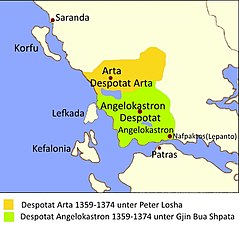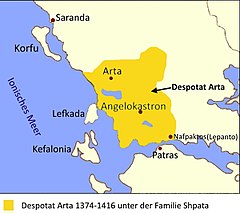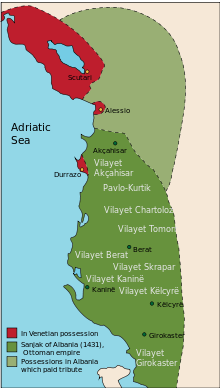Çamëria

Çamëria , German Tschameria ( Albanian Çamëria , Greek Τσαμουριά Tsamouriá , Turkish Çamlık ), is a coastal region in historical Epirus in what is now southern Albania and northwest Greece . In the ethnic Albanian national historiography it is the home of the Albanian-speaking population of the Çamen and is accordingly associated with them.
location
Under the Ottoman rule, the mountainous region of the southwestern Balkan Peninsula was called Çamlık. Today Çamëria is on both sides of the Greek-Albanian border. In Greece it includes the regional units Thesprotia , Preveza and some places in the eastern regional unit Ioannina in the Epirus region . In Albania it extends to the coastal region south of Himara to the Greek border.
Apart from geographic uses, the term has also taken on irredentist associations in Albania today .
Origin of name
Çamëria, as a noun of the Albanian demonym çam , comes from the ancient Greek name of the river Thyamis (Tsiamis), which is now called Kalamas , via an extinct local Slavic intermediate form * čamŭ or * čama , in turn from an older * tjama . Unlike Vladimir Orel , Eqrem sees Çabej çam as a direct derivation from Thyamis.
After the region was incorporated into Greece (1913), the term Tsamidis (Τσαμηδης) mainly identified the Albanian-speaking Muslims of the region.
However, the term Çamëria is mainly used today by the Albanians for the coastal region along the Ionian coast from Konispol north to south of the Acheron Valley in the Saranda district in southern Albania.
history
The history of Çamëria largely follows that of the historical region of Epirus .
Antiquity
In ancient times, Çamëria belonged to the Chaonia landscape and extended roughly from Amantia in the north to the Thyamis river in the south, including the Cestrine landscape . In the southeast, Chaonia bordered the Molossia , in the south on Thesprotia , in the northeast the border cannot be drawn so clearly. The capital was Phoinike .
middle Ages
The area of Çamëria belonged to the Roman and later to the Byzantine Empire in the Middle Ages . Before the 4th Crusade, Epirus was a forgotten region in the Byzantine world. When Franco-Flemish crusaders and Venetians invaded the areas of the Byzantine Empire during the Fourth Crusade (1204) and Constantinople was sacked and conquered, the Despotate of Epirus , founded by Michael I Komnenos Dukas Angelos around 1205, became a destination for many Greek refugees from Constantinople, Thessaly and the Peloponnese , who wanted to escape Latin rule.
In a Venetian document from 1210, the earliest mention of "Arbanenses" (Albanians) in the region of Epirus, who lived in the area opposite the island of Corfu . Byzantine sources depict the Albanians as poor and autonomous nomads who raided fortified cities. The first appearance of the Albanians in "tanta quantitate numerosa" (large amount) comes from a letter of the Venetian Marino Sanutus Torsello (1270-1343) from the year 1325, in which he mentions the presence of masses of Albanians in Thessaly, those of Moved place to place and destroyed the lands outside the walls. This type of Albanian presence on the territory of the Despotate of Epirus is not documented until 1337, when Albanians revolted around Berat and Kanina and carried out raids and looting of cities and castles.
From 1272 Çamëria belonged to the Regnum Albaniae , which stretched from Durrës south along the coast to Cape Gjuhëz on the Karaburun peninsula with unclear borders inland. Taking advantage of the Byzantine Civil War (1341-1347) and a great plague epidemic (1347/1348) in Epirus and Thessaly, the Serbian Tsar Stefan Dušan, with the support of various Albanian princes and their tribesmen , conquered the despotate of Epirus and thus Çamëria, Acarnania and Aetolia and incorporated it into his Serbian empire .
With the death of the Emperor of Serbs, Greeks, Albanians and Bulgarians, Stefan Dušan (1355) and the collapse of the Serbian Empire (1355), a number of feudal principalities were established on the Albanian territory, which did not lead to a union of forces against the expansion of the Muslims Ottomans in Epirus, but fought one another, gradually separated and thus became defenseless for the Ottomans. The boundaries of these feudal principalities changed from year to year, even from month to month.
Stefan Dušan's half-brother, Simeon Uroš Palaiologos , saw the opportunity to claim the Serbian throne and moved against his nephew Stefan Uroš V , but was defeated in 1356 and withdrew to Thessaly and Epirus, where he initially ruled Epirus with his brother-in-law Nikephoros II. Orsini , the last despot of Epirus from the Orsini dynasty (1335-1359). Nikephorus fell in the spring or summer of 1359 fighting the Albanian princes Peter Losha and Gjin Bua Shpata in the battle of the Acheloos .
The failure of the Serbian Empire as a power of order in the Western Balkans and the death of Nikephorus ultimately resulted in the complete dissolution of the despotate of Epirus. Numerous petty and war princes of different origins, including Serbs , Albanians and Italians , held individual cities or small regions with a few castles and almost constantly waged war against each other. Among them were the rival princes Thomas Preljubović and Simeon Uroš Palaiologos. The latter was able to bring Thessaly and Epirus largely under his control and divided the rulership into territories.
The Çamëria region has been divided into four areas:
- that of Gjin Zenevisi with the capital Argyrokastron , which today belongs to Albania,
- that of Simeon Uroš Palaiologos , which was further subdivided around 1366. The eastern part went to his son-in-law Thomas Preljubović, son of the most important military leader of the emperor Stefan Dušan, which today belongs to Albania.
- The two southern areas, the Despotate Arta under Peter Losha and the Despotate Angelokastro under Gjin Bua Shpata, belong to Greece today.
The Albanian part of Çamëria
Little is known about the historical region of Çamëria in present-day Albania. Between 1386 and 1417 when it was conquered by the Ottomans, it was a disputed territory between the despotate of Epirus and the Albanian clan of Gjin Zenevisi.
The Greek part of Çamëria
The despotate of Arta
After Losha's death, Bua Shpata brought Angelokastro under his control in 1374 and Nafpaktos (Lepanto) in 1378 . His dominion now extended from the Gulf of Corinth to the Acheron .
Subsequently, there were internal disputes and successive clashes with the neighbors (including the rising power of the Muslim Ottomans since the 1360s ), which led to the overthrow of the Albanian rule and its ruler, the Albanian family Bue Shpata . The wars between the Shpata and the Italian Tocco and indirectly for the neighboring rulers were particularly difficult .
In 1416 the Islamized Yaqub Shpata was conquered by Carlo I. Tocco ( Count Palatine of Kefalonia and Zakynthos and Despot of Epirus), who incorporated the despotate Arta into his empire. The Tocco turn gradually gave way to the Ottomans, who in 1431 the southern part of Çamëria occupied and Carlo II. Tocco allowed (nephew Carlos I), Arta, Akarnania and its islands ( Kefalonia and Zakynthos ) against payment of an annual tribute as Ottoman vassal continue to govern. The archons acquired the continuation of their privileges through the customary poll tax .
In order to get support against the Ottomans, Carlo II asked the Republic of Venice for protection, otherwise “he would be forced to come to an agreement with the Genoese , Catalans or the Ottomans.” When the sultan's fate seemed to wane in 1444 , Carlo II renounced the Ottoman rule. In this bold step he was advised and supported by his father-in-law Giovanni I. Ventimiglia (* 1382; † 1473 Castelbuono 1473;) 1st Marquis of Geraci etc., governor of the city of Naples. This landed with a small cavalry and briefly defeated the Ottoman army. After his return home Carlo was captured by the Ottomans a short time later and had to submit again as a vassal until his death on September 30, 1448.
Ottoman period
Çamëria belonged to Sanjak Albania until 1466 and then to Sanjak Avlona when it was divided between Greece and Albania.
From the Albanian Çamëria and more precisely from Piqeras , Lukova , Klikursi , Shën Vasil and Nivica-Bubar , relatives of the Granatieri Real Macedone foreign regiment (also known as the Real Macedonia Infantry Regiment) emigrated to the Kingdom of Naples , where 18 Greek-Albanian were To provide families of King Charles VII in Abruzzo with everything they needed for farming in addition to 793 tomoli (approx. 320 hectares ), including animals and agricultural implements. In addition, the Greek-Albanian families received a 20-year tax exemption from every peso and censo , which as a rule each subject had to pay to the royal house. ( See main article : Villa Badessa , Albanian Immigration to Italy (1743) )
1909 Çamëria under the Turkic terraced name was Çamlık as a separate Sandzak furnished. The main town was Igoumenitsa determines its previous Albanian name Gomoniçe honor of the new Sultan Mehmed V. Reşad in Reşadiye was changed. The Sandschak also included the Kazas Margaliç (today: Margariti ) with the city of Parga , Aydonat (today: Paramythia ) and Filât (today: Filiates ). The last mutasarrif of the sanjak was Mahmud Ekrem Bey from the Libohova-Aslanpaşalı family. After a vain defense against the Greeks in the 1st Balkan War, he withdrew to Albania and then continued to fight against the Greek troops on the Albanian side. In the newly founded state of Albania he continued his career under the name Eqrem Libohova . She led him through various ministerial posts up to the office of Prime Minister of Albania.
After the Balkan Wars and the First World War
After most of the Çamëria fell to Greece, the area there was given the ancient name of Thesprotia and the place names of Albanian origin were Hellenized.
See also
Remarks
- ↑ Tomolo (singular from Tomoli) is an old area measure for agricultural areas, which was used in some Italian provinces of southern Italy.
Individual evidence
- ↑ George Gawrych: The Crescent and the Eagle: Ottoman rule, Islam and the Albanians, 1874-1913 . Tauris Academic Studies, London 2006, ISBN 978-1-84511-287-5 , pp. 23 (English, online preview in Google Book Search).
- ^ Robert Elsie : The Cham Albanians in Greece: A Documentary History . 2012, ISBN 978-1-78076-000-1 , pp. XXIX (English).
- ↑ Vladimir Orel: Albanian etymological dictionary . Brill, 1998, pp. 49 ff . (English).
- ↑ Athanasios Gotovos: E τερότητα και συγκρουση: ταυτοτητες στην κατοχική θεσπρωτία και ο ρολος τηανεης μουσουόλτατες μουσουόλατινταντης μουσουτλατκτες μουσουόλτατεσσμηντης μουσου . In: Δωδώνη: Επιστημονική Επετηρίδα Τμήματος Φιλολοσοφίας, Παιδαγωγικής, Ψυχολογίας . Πανεπιστήμιο Ιωαννίνων, Φιλοσοφική Σχολή, Ioannina 2013, p. 36 (Greek, online [PDF; 1.4 MB ]).
- ^ Brendan Osswald: The Ethnic Composition of Medieval Epirus' . In: Imagining frontiers. Contesting identities . Pisa University Press, Pisa 2006, pp. 132 (English, online preview in Google Book Search).
- ↑ Gottlieb Lukas Friedrich Tafel , Georg Martin Thomas : Documents on the earlier commercial and state history of the Republic of Venice, with special reference to Byzantium and the Levant. From the ninth to the end of the fifteenth century . Part 2, Volume XIII. Vienna 1856, p. 122 (Latin, archive.org ).
- ↑ a b Konstantinos Giakoumis: Fourteenth-century Albanian migration and the 'relative autochthony' of the Albanians in Epeiros. The case of Gjirokastër . In: Byzantine and Modern Greek Studies . tape 27 , 2003, p. 177 (English).
- ↑ Gottlieb Lukas Friedrich Tafel , Georg Martin Thomas : Documents on the earlier commercial and state history of the Republic of Venice, with special reference to Byzantium and the Levant. From the ninth to the end of the fifteenth century . 1st part, volume XII. Vienna 1856, p. 500 (Latin, archive.org ).
- ^ John Fine: The Late Medieval Balkans: A Critical Survey from the Late Twelfth Century to the Ottoman Conquest . University of Michigan Press, 1994, ISBN 978-0-472-08260-5 , pp. 320 (English, online preview in Google Book Search).
- ↑ Spiridion Gopevi: The Principality of Albania . Hermann Paetel, Berlin 1914, p. 9 ( online preview in Google Book Search).
- ^ Edwin E. Jacques: The Albanians: An Ethnic History from Prehistoric Times to the Present . Jefferson, NC: McFarland & Co, 1995, pp. 164 (English, online preview in Google Book Search).
- ^ Donald M. Nicol : The Byzantine family of Kantakouzenos (Cantacuzenus) approx. 1100-1460. A genealogical and prosopographical study . In: Dumbarton Oaks studies . tape 11 . Dumbarton Oaks Center for Byzantine Studies, Washington DC 1968, pp. 132 (English).
- ↑ John Van Antwerp Fine, p. 349 ff.
- ^ Marie-Claude Marandet: La ville et le plat pays . Presses universitaires, Perpignan 2017, ISBN 978-2-35412-288-1 , pp. 181 (French, online preview in Google Book Search).
- ^ Nicholas Geoffrey Lemprière Hammond: Migrations and Invasions in Greece and Adjacent Areas . Noyes Press, Park Ridge, NJ 1976, ISBN 0-8155-5047-2 , pp. 59 (English).
- ^ Donald MacGillivray Nicol: The Despotate of Epiros 1267-1479: A Contribution to the History of Greece in the Middle Ages . Cambridge University Press, 1984, ISBN 978-0-521-26190-6 , pp. 142 (English, online preview in Google Book Search).
- ↑ Luka Petanović: Elena: l'ultima imperatrice bizantina . Editoriale Jaca Book SpA, Milan 2006, ISBN 88-16-43518-6 , pp. 136 (Italian, online preview in Google Book Search).
- ^ John Van Antwerp Fine, p. 356
- ^ Peter Bartl: Tocco, Carlo . In: Biographical Lexicon on the History of Southeast Europe . tape 4 : R-Z. Oldenbourg, Munich 1981, ISBN 3-486-42421-1 , p. 333 .
- ↑ Ethnos . In: Handbook of the European ethnic groups . tape 8 . Wilhelm Braumüller , Vienna 1970, p. 576 .
- ^ John Van Antwerp Fine, p. 544
- ^ A b William Miller: The Latins in the Levant, a history of Frankish Greece (1204-1566 . EP Dutton and Company, New York 1908, pp. 396 (English, archive.org ).
- ^ I Ventimiglia: conti di Geraci - Linee antiche. Retrieved February 20, 2018 (Italian).
- ^ Ventimiglia - Marchesi di Geraci (siculo) e Principi di Castelbuono. Retrieved February 20, 2018 (Italian).
- ^ William Miller, p. 415
- ↑ Kosta Giakoumi: The Ottoman Advance and Consolidation in Epirus and Albania During the Fourteenth and Fifteenth Centuries. Accessed April 7, 2018 .
- ^ Lino Bellizzi: Villa Badessa, Oasi orientale in Abruzzo. 1 ^ Edizione . Tracce, Pescara 1994, pp. 67 (Italian).
- ↑ Federico Roggero: La Colonizzazione di Bozza e Badessa negli atti demaniali della Provincia di Teramo . In: Francesco Rimoli (ed.): Immigrazione e integrazione. Dalla prospettiva global all realtà locali . tape 1 . Editoriale Scientifica, Naples 2014, p. 547 (Italian, unite.it [PDF; accessed April 7, 2018]).
- ↑ Hans-Jürgen Kornrumpf: The Sandschak Çamlık Notes on a short-lived late Ottoman administrative district In: Contributions to Ottoman history and territorial administration. The Isis Press, Istanbul 2001, ISBN 975-428-199-8 ( Analecta Isisiana Volume 55), pp. 389-394, first published in 1984 in: Balcanica 15, 121-126







